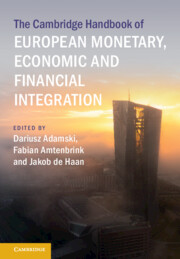Book contents
- The Cambridge Handbook of European Monetary, Economic and Financial Integration
- The Cambridge Handbook of European Monetary, Economic and Financial Integration
- Copyright page
- Contents
- Contributors
- Introduction
- Part I The Economic and Monetary Union
- Part II The Monetary Dimension
- Part III The Economic and Fiscal Dimensions
- 15 Reviving the Case for Policy Coordination in EMU
- 16 Ten Years of the European Semester
- 17 The EU Fiscal Rules
- 18 National Fiscal Policy in EMU
- 19 The Politics of Fiscal Integration in Eurozone Reforms and Next Generation EU
- 20 Adjustments in Economic Crises
- 21 Designing a Permanent EU-Wide Stabilization Facility
- 22 Enhancing Private and Public Risk Sharing
- Part IV Financial Integration
- Index
- References
15 - Reviving the Case for Policy Coordination in EMU
from Part III - The Economic and Fiscal Dimensions
Published online by Cambridge University Press: 28 September 2023
- The Cambridge Handbook of European Monetary, Economic and Financial Integration
- The Cambridge Handbook of European Monetary, Economic and Financial Integration
- Copyright page
- Contents
- Contributors
- Introduction
- Part I The Economic and Monetary Union
- Part II The Monetary Dimension
- Part III The Economic and Fiscal Dimensions
- 15 Reviving the Case for Policy Coordination in EMU
- 16 Ten Years of the European Semester
- 17 The EU Fiscal Rules
- 18 National Fiscal Policy in EMU
- 19 The Politics of Fiscal Integration in Eurozone Reforms and Next Generation EU
- 20 Adjustments in Economic Crises
- 21 Designing a Permanent EU-Wide Stabilization Facility
- 22 Enhancing Private and Public Risk Sharing
- Part IV Financial Integration
- Index
- References
Summary
Fiscal policy in the euro area has been bound by the Maastricht Treaty criteria. The chapter evaluates what this has meant for the effectiveness of fiscal policy, and observes that it has led to suboptimal investments, has been on average procyclical, and has let monetary policy carry the burden of macroeconomic management. The chapter shows that by construction the Maastricht framework has been one that constrains countries, rather than coordinating them. Moving forward, it can be expected that fiscal policy will have a much more active role to play. NextGenerationEU can serve as a good template for coordinating fiscal policy, at least for the big European public goods, like the climate.
- Type
- Chapter
- Information
- Publisher: Cambridge University PressPrint publication year: 2023



